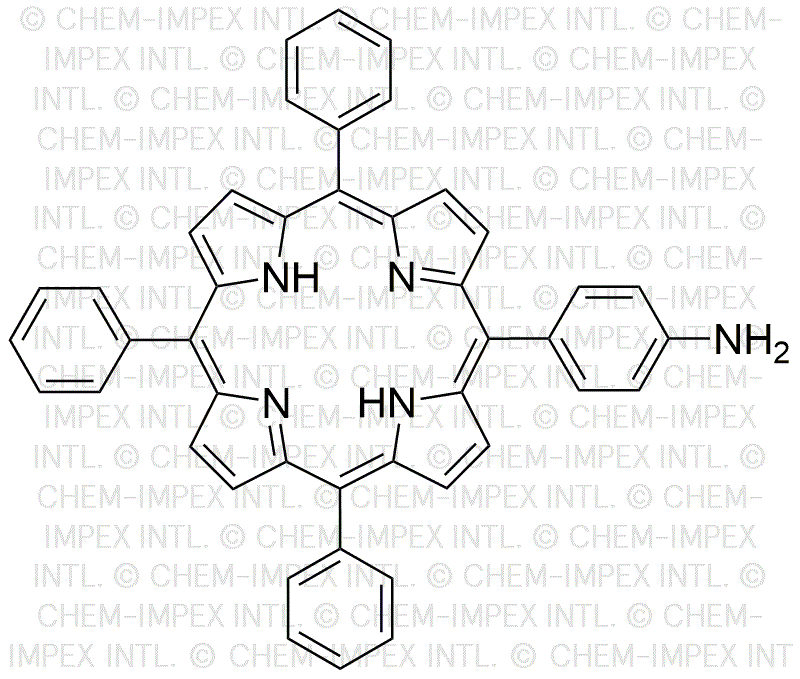5-(4-Aminophenyl)-10,15,20-(triphenyl)porphyrin is widely utilized in research focused on:
- Photodynamic Therapy: This compound is effective in cancer treatment, where it can be activated by light to produce reactive oxygen species that selectively destroy tumor cells.
- Fluorescent Probes: Its unique structure allows it to be used as a fluorescent marker in biological imaging, helping researchers visualize cellular processes in real-time.
- Solar Energy Conversion: The compound can be incorporated into solar cells to enhance light absorption and improve energy conversion efficiency, making it valuable in renewable energy applications.
- Chemical Sensors: It serves as a sensing material for detecting environmental pollutants, offering a sensitive and selective method for monitoring air and water quality.
- Drug Delivery Systems: Its ability to form complexes with various drugs allows for targeted delivery, improving therapeutic efficacy while minimizing side effects.
General Information
Properties
Safety and Regulations
Applications
5-(4-Aminophenyl)-10,15,20-(triphenyl)porphyrin is widely utilized in research focused on:
- Photodynamic Therapy: This compound is effective in cancer treatment, where it can be activated by light to produce reactive oxygen species that selectively destroy tumor cells.
- Fluorescent Probes: Its unique structure allows it to be used as a fluorescent marker in biological imaging, helping researchers visualize cellular processes in real-time.
- Solar Energy Conversion: The compound can be incorporated into solar cells to enhance light absorption and improve energy conversion efficiency, making it valuable in renewable energy applications.
- Chemical Sensors: It serves as a sensing material for detecting environmental pollutants, offering a sensitive and selective method for monitoring air and water quality.
- Drug Delivery Systems: Its ability to form complexes with various drugs allows for targeted delivery, improving therapeutic efficacy while minimizing side effects.
Documents
Safety Data Sheets (SDS)
The SDS provides comprehensive safety information on handling, storage, and disposal of the product.
Product Specification (PS)
The PS provides a comprehensive breakdown of the product’s properties, including chemical composition, physical state, purity, and storage requirements. It also details acceptable quality ranges and the product's intended applications.
Certificates of Analysis (COA)
Search for Certificates of Analysis (COA) by entering the products Lot Number. Lot and Batch Numbers can be found on a product’s label following the words ‘Lot’ or ‘Batch’.
*Catalog Number
*Lot Number
Certificates Of Origin (COO)
This COO confirms the country where the product was manufactured, and also details the materials and components used in it and whether it is derived from natural, synthetic, or other specific sources. This certificate may be required for customs, trade, and regulatory compliance.
*Catalog Number
*Lot Number
Safety Data Sheets (SDS)
The SDS provides comprehensive safety information on handling, storage, and disposal of the product.
DownloadProduct Specification (PS)
The PS provides a comprehensive breakdown of the product’s properties, including chemical composition, physical state, purity, and storage requirements. It also details acceptable quality ranges and the product's intended applications.
DownloadCertificates of Analysis (COA)
Search for Certificates of Analysis (COA) by entering the products Lot Number. Lot and Batch Numbers can be found on a product’s label following the words ‘Lot’ or ‘Batch’.
*Catalog Number
*Lot Number
Certificates Of Origin (COO)
This COO confirms the country where the product was manufactured, and also details the materials and components used in it and whether it is derived from natural, synthetic, or other specific sources. This certificate may be required for customs, trade, and regulatory compliance.


